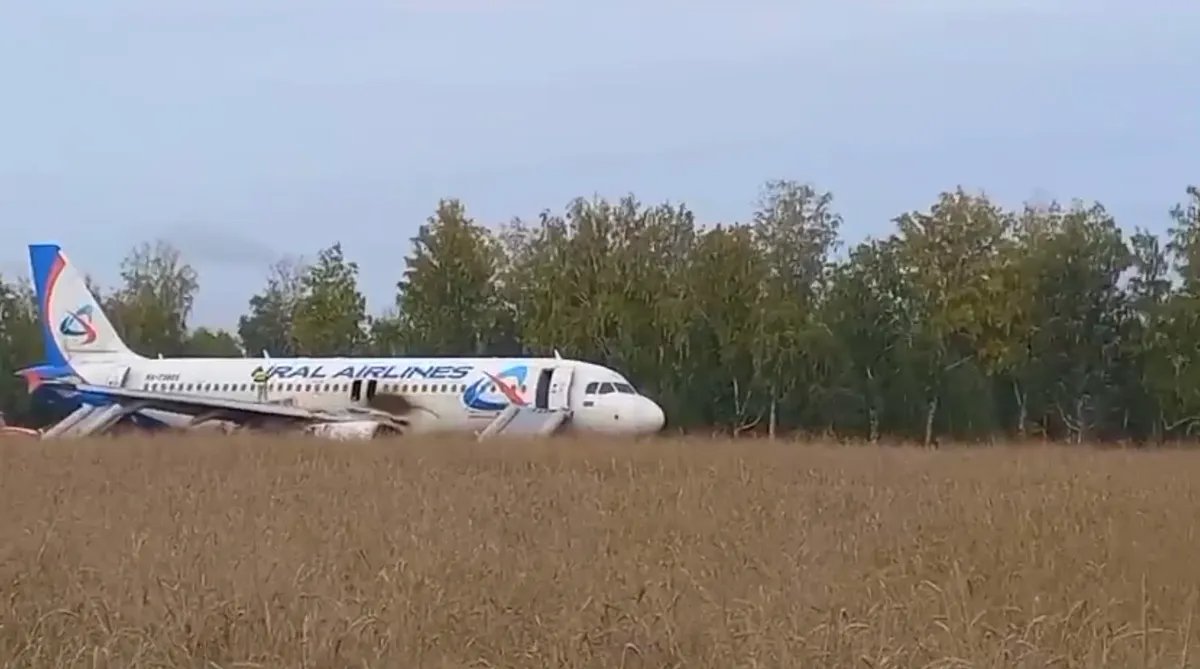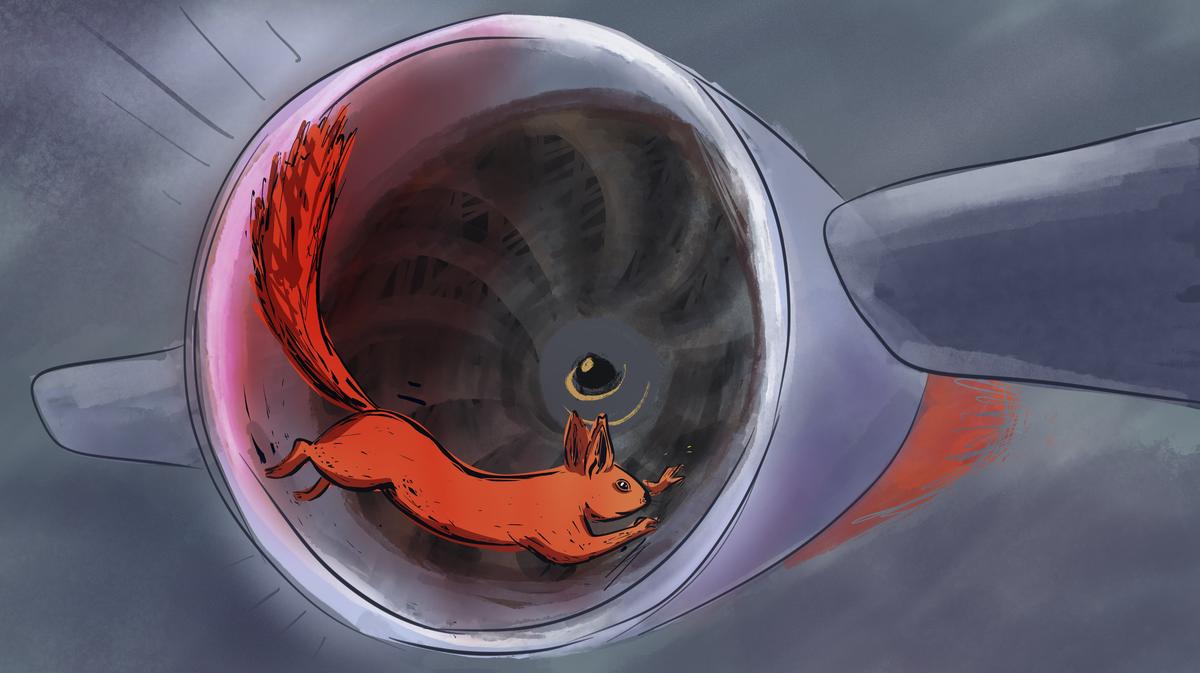Russia’s poor flight safety record has for years been far worse than those of developed nations, but the Western sanctions imposed over the war in Ukraine appear to be further worsening the situation, with the number of civil aviation incidents doubling during 2023 despite an overall reduction in the number of flights.

An Airbus A320 used by Ural Airlines. Screenshot
Fewer flights, more failures
Following its audit of Russia’s flight safety last September, The International Civil Aviation Organisation (ICAO) issued it with “red flag” status, ranking it alongside Bhutan, The Democratic Republic of Congo, and Liberia as one of the four most dangerous countries to fly in the world.
“Unfortunately, the ICAO red flag status is not just a political gesture as many believe,” one aviation expert told Novaya-Europe, asking to remain anonymous. “It reflects how things really are.”
This is borne out by the open-source data collected by Novaya-Europe for this investigation, which found that there were over 120 aviation incidents involving passenger planes used by Russian airlines in the first eight months of this year. This figure is 2.2 times higher than it normally is: between 2018 and 2022, an average of 55 incidents were recorded during the same period. So far this year, there have already been more aircraft malfunctions than there have been in any full year in the past.
Significantly, the increase in passenger aviation incidents has gone hand-in-hand with a reduction in Russian air traffic volume: simply put, there are now fewer flights, but the number of incidents is rising.
Citing the classified statistics provided by Rosaviatsia, Russia’s civil aviation agency, business newspaper Vedomosti reported in January that Russia’s overall air traffic volume declined by 13% in 2022 compared to the previous year, and by 25% compared to 2019, the last year before the pandemic.
A recent prediction made by the Russian Transport Ministry suggested that the figure for 2023 would only be 9% lower than that of 2021.
However, verifying these figures is not possible as Rosaviatsia classified the air traffic statistics in 2022. One aviation expert told Novaya-Europe the 2023 forecast was unrealistic, given that 11 airports are currently closed in southern Russia due the war in Ukraine, as well as three of the five terminals at Moscow’s Sheremetyevo airport, the country’s biggest flight hub. “If this doesn’t clearly indicate that air traffic has declined,” they asked, “what does?”
Poor track record
The serious issues faced by Russia’s aviation industry were well documented long before the invasion of Ukraine and the imposition of Western sanctions. Over the past 23 years, more people have been killed in Russian plane crashes than in plane crashes in any other country in the world.
In our research, we excluded air accidents which related to terrorism or high jacking given that such incidents are unrelated to airline safety records.
However, the picture looks even worse when you look at fatality rates, or the ratio of air accident deaths to the number of total passengers carried.
This figure shows what the real risk of taking a plane is, whereas a high number of crashes may simply result from a high number of flights. For instance, US airlines transported seven times as many passengers as Russian airlines in 2021, and 50 times more than Iranian ones, making the margin between Russian and US airline safety records even larger.
That makes the ratio of people killed in plane crashes to the number of total passengers 18 times higher in Russia than it is in the US, but 2.3 times lower than in Iran (using data for 2021), which is ironic given that Iran is now the country Russia is forced to rely on for aircraft maintenance.
However, Iran’s plane crash mortality rate is gradually declining, and there hasn’t been a single fatal aviation accident involving an Iranian airline in the past three years. In Russia, 2022 and 2023 were also good years for airline safety compared to 2021, when the country set a world record for the number of plane accidents with 31 crashes including military and private aircraft.
Domestic-made plane crashes
In April 2022, Russia’s passenger aircraft fleet had 1,287 planes: 470 (37%) of which were made in Russia or the Soviet Union and its successor states, while the remaining 817 (63%) were foreign made, of which 700 were leased from companies abroad and listed in foreign aeronautical registers.
However, 95% of the country’s passenger air traffic used foreign-made planes.
When Russian airlines were cut off from the outside world by the introduction of Western sanctions last year, they responded by refusing to return leased foreign aircraft to their owners. The Russian government allowed airlines to re-register most of them in its domestic register by April 2022, meaning that Russian airlines, as the aircraft’s new owners, became responsible for their maintenance.
Russia’s own flight safety management system is extremely inefficient, and some experts even believe it does not exist at all.
We analysed the statistics on lethal plane crashes between 2000 and 24 February 2022 and found out that over 80% of them involved planes registered and maintained in Russia. The chances of dying in such a plane are 20 times higher than would be the case in a leased one.
Accident prevention and legal regulation are not well-established in Russian aviation, one expert told Novaya-Europe. On top of that, there are now sanctions that mean an end to manufacturer-authorised maintenance works, easy access to original parts, and aviation software unable to be updated or foreign software engineers hired.
Not the same Boeings
The leased flying stock was once the safest part of Russia’s passenger aviation fleet, but the fact that the Russian authorities will now be in charge of that doesn’t bode well.
In 2023, the frequency of incidents or accidents involving foreign planes jumped to a far higher level than before. Having never previously topped 40%, their proportion of the total number of incidents stood at around 60% in the first eight months of the year.
Of the 817 foreign-made planes in Russia’s passenger fleet in April 2022, at least 72 (9%) have already malfunctioned at least once, having been repaired by unauthorised service companies using spare parts of unknown origin.
Some of the spare parts are likely to have come from the “cannibalisation” of other aircraft, a process that has likely involved 25-30% of Russia’s entire flying stock, though there’s no precise data on this stripping for parts.
However, one aviation analyst told Novaya-Europe that cannibalisation slowed down in 2023 as the industry practice of using parallel imports grew, adding: “As long as there’s money, there’s supply.”
The Russian government sanctioned the use of off-brand spare parts in aircraft repair late last year, prompting one aviation expert to lament that the rules used by the aircraft leasing industry in the past simply don’t apply any more.
Unable to maintain Western safety standards without easy access to Western components, Rosaviatsia is constantly being forced to lower its own safety standards as, in the words of one expert, “there would be no planes to fly otherwise”.
Pilot departure
Over the years, Russian airlines have, in the words of Russian aviation expert Anastasia Dagaeva, “adopted the skills, procedures, technologies and standards” of their Western partners.
However, the pool of competent industry professionals such as pilots, technicians, and engineers is gradually “getting diluted” as many of them opt to leave Russia for better job prospects abroad.
One former Aeroflot pilot who himself took a job abroad in 2016, told us that more Russian pilots were now leaving the country than ever before. Over 300 pilots moved to Asia in the 2015–2017 wave of migration, business newspaper Kommersant says, with another 400 reportedly looking for jobs abroad in 2017.
Hopes on Iran
Iran is now willing to provide maintenance and repair services to Russian airlines, though it’s unlikely to look after Russian planes any better than it did its own.
There are currently 335 planes in Iran’s passenger fleet, but even in 2021, a year before Russia requested assistance from the country, half of those were going unused due to a shortage of spare parts caused by strict sanctions on Tehran.
Another problem is that Iran’s flying stock is far older than Russia’s, with its planes being an average of 28 years old, compared to Russia’s relatively youthful 14.6 years old, meaning that Iranian mechanics simply have no experience working with modern planes.
“Aeroflot is proud of having one of the lowest average age figures in Europe,” another expert says. "However, this means that those planes have a lot of electronics inside such as control panels, and all this needs regular updates, so that’s even worse. Iran is not able to work with this. There is one Russian plane that has been in Iran for maintenance for half a year already.”
The plane in question is an Aeroflot Airbus sent to Iran five months ago. The repair is still incomplete and is scheduled for March 2024.
The Russian government has said the country will produce over a thousand new aircraft by 2030, but each of the experts Novaya-Europe spoke to as part of this investigation considered that timeframe to be hugely over optimistic.
Most of the planes on the list have already faced critical production issues such as schedule overruns, failed safety tests, and a lack of spare parts.
As a result, Russia’s civil aviation industry is unlikely to get very far with substituting imports, while its problems with maintenance and flight safety will continue to pile up.
Join us in rebuilding Novaya Gazeta Europe
The Russian government has banned independent media. We were forced to leave our country in order to keep doing our job, telling our readers about what is going on Russia, Ukraine and Europe.
We will continue fighting against warfare and dictatorship. We believe that freedom of speech is the most efficient antidote against tyranny. Support us financially to help us fight for peace and freedom.
By clicking the Support button, you agree to the processing of your personal data.
To cancel a regular donation, please write to [email protected]

